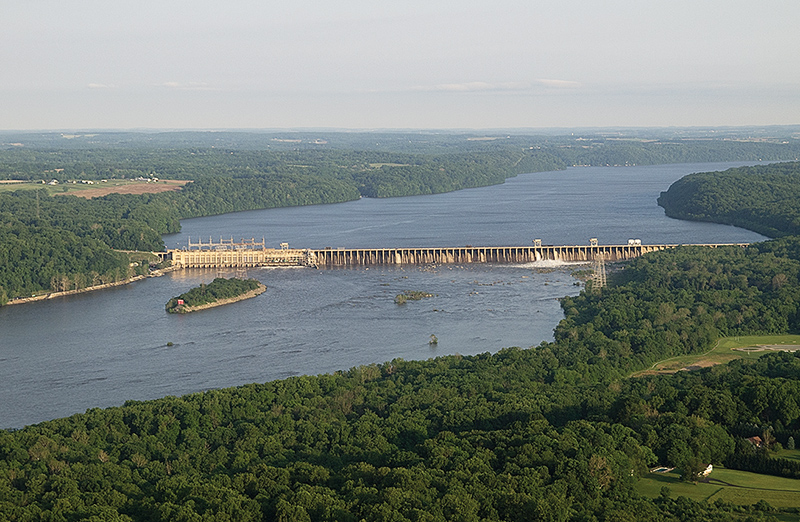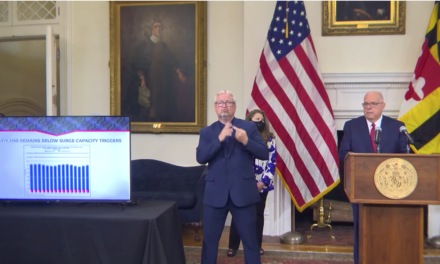By Karl Blankenship
Bay Journal
For years, the 94-foot-high Conowingo Dam was considered a “time bomb” looming over Chesapeake Bay cleanup efforts, as it would begin spilling more water-fouling nutrients downstream when its 14-mile-long reservoir stopped trapping pollution.
But that was always considered a problem for the future. So, the challenge of defusing the “bomb,” located on the Susquehanna River in Maryland just 10 miles from the Chesapeake, was punted to the future as well.
“We faced a problem that we didn’t have a solution to at the time,” said Lee Currey, director of the Maryland Department of the Environment Water and Science Administration.
Recent analyses of monitoring data, though, have shown that the bomb actually went off years ago — but not with a resounding boom. Instead, there’s been a gradual increase in the amount of nitrogen and phosphorus swept past the concrete structure as its reservoir filled with sediment and hit a state of “dynamic equilibrium.”
To meet its cleanup goals, the state-federal Bay Program must now figure out how to offset an additional 6 million pounds of nitrogen and 260,000 pounds of phosphorus reaching the Bay each year.
That’s roughly a 2.5% increase in the total amount of nutrients entering the Chesapeake. While the percentage may seem small, it would likely require tens — if not hundreds — of millions of dollars to address, on top of a cleanup program already expected to cost billions.
Currey recently worked with a team of state and federal officials that is trying to fix that problem. While some key questions remain unanswered — including how much the additional pollution reductions will cost and when they will be completed — the team recently produced a framework for moving forward, which was accepted by Bay Program leaders in March.
Stricter ‘pollution diet’
The framework calls for all states in the watershed to work on a new, collaborative watershed implementation plan, or WIP, aimed specifically at reducing enough nutrient pollution to offset the impact of more nutrients flowing past Conowingo.
The WIP will be written by representatives from the six states in the watershed, along with the District of Columbia and Chesapeake Bay Commission — a legislative advisory panel. It will be an addition to the WIP each state has written — and is now updating — to achieve its own share of the nutrient reduction goals that were set in 2010 by the U.S. Environmental Protection Agency through the Chesapeake Bay Total Maximum Daily Load.
Often referred to as a “pollution diet,” the TMDL established nutrient and sediment caps for each state and river. The caps are intended to reduce algal blooms, improve water clarity and enhance oxygen levels to sustain fish, crabs, oysters and other aquatic life.
The Conowingo plan will identify nutrient reduction efforts that go “above and beyond” those in the state plans. The rationale for the shared plan, Currey said, is that Bay-wide water quality benefited when Conowingo was trapping nutrients, effectively lessening the amount of cleanup work each state had to do. Now that those nutrients are being washed downstream, all of the jurisdictions should pool their resources and work together to offset their impact.
But rather than spread the implementation among all jurisdictions, the WIP will target nutrient control actions to areas where they will be most effective in offsetting the dam’s impact — primarily parts of Pennsylvania, New York and Maryland.
If the burden were spread among all Bay jurisdictions, it would require significantly more nitrogen reductions. That’s because reductions from more southern areas tend to be less effective at offsetting the impact of Conowingo, which is located near the top of the Bay.
“When setting the caps, jurisdictions benefited from the reservoir’s past pollution-trapping capacity,” Currey said. “But it is not functioning in that capacity anymore. Now, there is an incentive for us all to work together and, in the end, to end up saving money.”
The plan will be completed by early next year and presented for public review, along with updated WIPs being prepared by each state.
Funding isn’t clear
Exactly how the Conowingo plan will be funded isn’t clear. At least a chunk of the money is expected to come from Exelon, the utility that owns Conowingo, which is seeking a new multi-decade license from the Federal Energy Regulatory Commission to continue operating the hydro facility.
As part of the relicensing process, Maryland must first certify that the dam’s operation will comply with state water quality standards. To make that certification, the Maryland Department of the Environment (MDE) is likely to require Exelon to address water quality issues in the river immediately upstream and downstream of the dam, but it will also likely have a role in implementing the new WIP.
The MDE will make a decision about the certification in mid-May. It won’t be known until then how much Exelon might have to pay toward nutrient reductions.
But implementing enough on-the-ground actions to offset more than 6 million pounds of nitrogen would likely cost many millions of dollars, and it’s unlikely that Exelon alone could foot the bill.
“Once we know how much additional capital results from [the Conowingo certification], there may be a gap,” Currey said. “Then the question is, ‘How do we best close that gap?’”
To help answer that question, the EPA will soon seek a third-party contractor to manage the implementation of the Conowingo WIP. That includes identifying where pollution control practices can be implemented most cost-effectively and overseeing pooled money to implement the plan.
But a major part of the job will be identifying sources of money that could help plug any funding gap. Options could range from finding previously untapped sources of federal funding to testing new types of public-private partnerships that could bring more nongovernmental money to the effort.
How long will it take?
Identifying and obtaining funding is key to answering the ultimate question: How long will it take to offset the dam’s impact? The TMDL goal is to take all actions needed to achieve Bay water quality goals by 2025. Whether the new Conowingo plan can be implemented by then, Currey said, will likely hinge on the success of the financial strategy — and how quickly the money can be raised.
The EPA ultimately has the responsibility of ensuring that nutrient reduction plans are being implemented. With other WIPs, it can take a variety of actions against a specific state that’s falling short of its goals.
In the case of the Conowingo WIP, which will be a collaborative effort, it’s less clear how the states will be held accountable if the plan is not working.
One possibility, said Rich Batiuk, associate director for science with the EPA Bay Program Office, is that the agency could decide to assign specific additional pollution reductions to each state. But, he said, the agency views
the Conowingo WIP as an innovative solution to a complex problem which — if successful — might be replicable elsewhere.
“We want to give it a good, honest try and give it time,” Batiuk said. “We would like to see how this model would work.”





Recent Comments